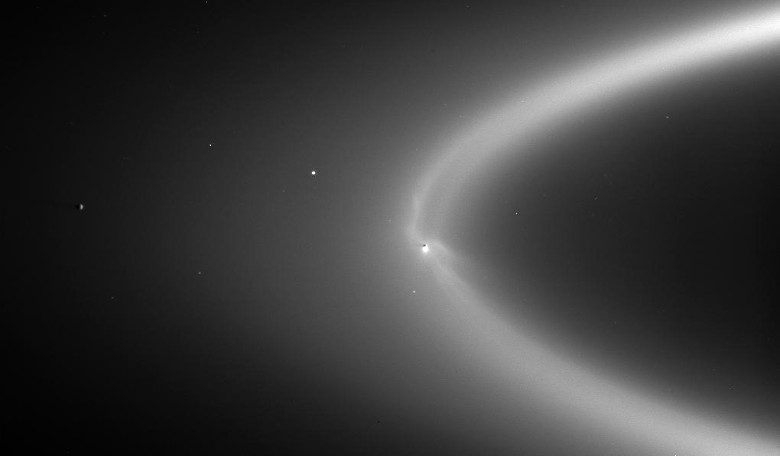Material ejected from plumes on Enceladus could be helping to enrich its surroundings with methanol, suggest researchers who have recently spotted this organic molecule in unexpected large quantities in the E-ring around Saturn.
Over a decade ago, Cassini revealed to scientists that cryovolcanoes near the south pole on Enceladus were shooting geyser-like supersonic jets of water vapour, other gases, and ice particles into the space around Saturn. Such activity from this modest sized moon (which has a diameter of only 504 kilometers), prompted intensive research which has subsequently revealed that it is the only known icy world in the Solar System with ongoing deep-seated geological activity.
The jets of water obviously need to come from somewhere, so it has also been suggested that a subsurface saltwater sea more than likely exists under the south pole, between the ice shell and the silicate core. Methanol, which is an organic chemical compound, is produced naturally in the anaerobic metabolism of many varieties of bacteria, hence it regularly gets associated with life on other planets; coupled with a subsurface liquid ocean, it is a tantalising prospect that life could be present under the surface of Enceladus.
However, despite the large abundances found, the methanol which has been detected by researchers at Cardiff University and The Open University in the UK, is not thought to be jettisoned directly from Enceladus’s oceans but is a result of the chemical transformation of material spewed by the geysers, once vented into space.
“Recent discoveries that icy moons in our outer Solar System could host oceans of liquid water and ingredients for life have sparked exciting possibilities for their habitability. But in this case, our findings suggest that that methanol is being created by further chemical reactions once the plume is ejected into space, making it unlikely it is an indication for life on Enceladus,” said Dr Emily Drabek-Maunder of Cardiff University, who presented the results at the National Astronomy Meeting held this week at the University of Hull in the UK.
Methanol has been found in Enceladus’s plumes before but not in the quantities found by the team who have suggested that the large volumes could be a result of the compound being trapped by Saturn’s magnetic field.
“This observation was very surprising since it was not the main molecule we were originally looking for in Enceladus’s plumes,” says Dr Jane Greaves of Cardiff University who was also involved with the study.
Nonetheless, the discovery also heralds another success as the compound was found using the IRAM 30-metre radio telescope in the Spanish Sierra Nevada. As Cassini is due to end its journey in only a couple of months time, other means in which to study the planets will be needed in order to fill the gap before missions such as JUICE get underway.
“This finding shows that detections of molecules at Enceladus are possible using ground-based facilities. However, to understand the complex chemistry in these subsurface oceans, we will need further direct observations by future spacecraft flying through Enceladus’s plumes,” adds Drabek-Maunder.











